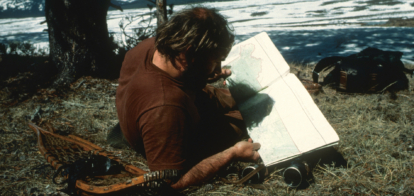Was It Worth It?
Was It Worth It? captures the essence of a life committed to the wild and challenges readers to make certain that their answer to this universal question is yes.
Editor’s Note: In his latest memoir, Doug Peacock, iconoclast and environmentalist, observes that what he calls “solitary walks” made him who he is—a lifelong protector of the wilderness and its many awe-inspiring inhabitants. Recounting his journeys to wild places and his commitment to saving them, Doug asks the question many consider in their twilight years: Was it worth it? Doug was also the inspiration for Edward Abbey’s fictional character George Washington Hayduke—and while only Ed could know how those particular threads came together, the part of George that he borrowed from the real-life Doug had distinct origins that were rooted in wilderness and both the trauma and value of recovering from war.
The following is an excerpt from Was It Worth It?, published by Patagonia in January 2022.
The most indispensable wilderness experience in my life arrived quite accidentally in Yellowstone National Park during the decade after I returned from Vietnam. Accidental, because I stumbled into the park’s lodgepole pine forest at the peak of a hallucinatory malaria paroxysm (it started in the high eastern Wind River Range, so I knew what was coming) and dreamed of grizzlies that turned out to be real bears. That experience can’t be replicated today because of human crowding. It occurred long enough ago that the National Park Service didn’t especially think a wacko hiding out in their backcountry was worth looking for. That was the combat vet Edward Abbey met in 1968, and upon whom he later based the fictional character of George Washington Hayduke.
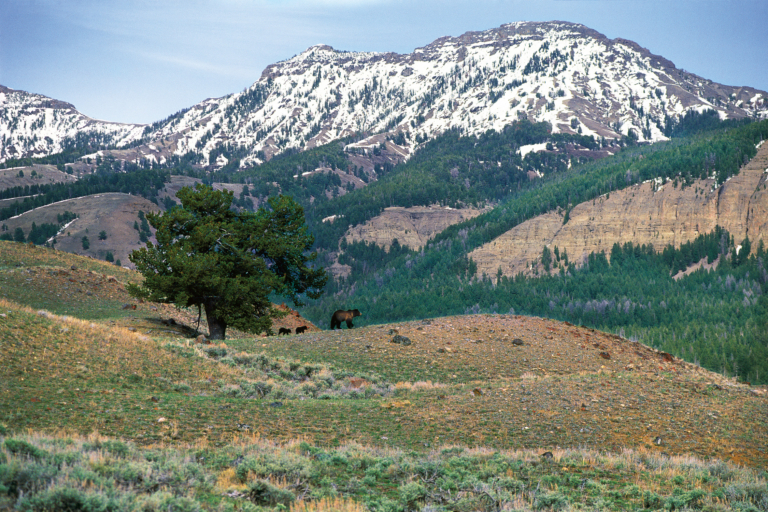
A mother grizzly roams with her new spring cubs. Yellowstone National Park, Wyoming. Photo: Thomas D. Mangelsen
With its wildlife, wilderness, and thermal areas of refuge from deep snows, I considered Yellowstone’s backcountry a paradise and wanted to indulge in pockets of it without interference from the outside world. This was still possible in a Yellowstone long before talk of bringing in fast food and the internet to National Park Service campgrounds. It also meant I had to hide out—like an escaped POW might have attempted in Vietnam.
At that time, there was no sane boundary for me between living in the edges of Yellowstone National Park and the fantasy of eluding capture by the Viet Cong hunting for me in the jungles of Vietnam. I had had one close call in Southeast Asia and had yet to shake the nightmare loose. I wanted to chisel the episode out of my life like a malignant lesion. But back then I couldn’t. I was terrified of someone finding me camped in the woods of America. I traveled with this irrational fear buried in my backpack while tramping across the meadows and through the lodgepole pine forests. The shrinks would try to provide clunky terminology for this pathology a decade and a half later with the term post-traumatic stress disorder—PTSD and such. In the meantime, I prowled around Yellowstone like a madman, leaving no tracks in the rapidly melting snow. I fit the criteria for a half-dozen paranoid categories, all of which I embraced as necessary for life in the wild. It pushed me to the edge.
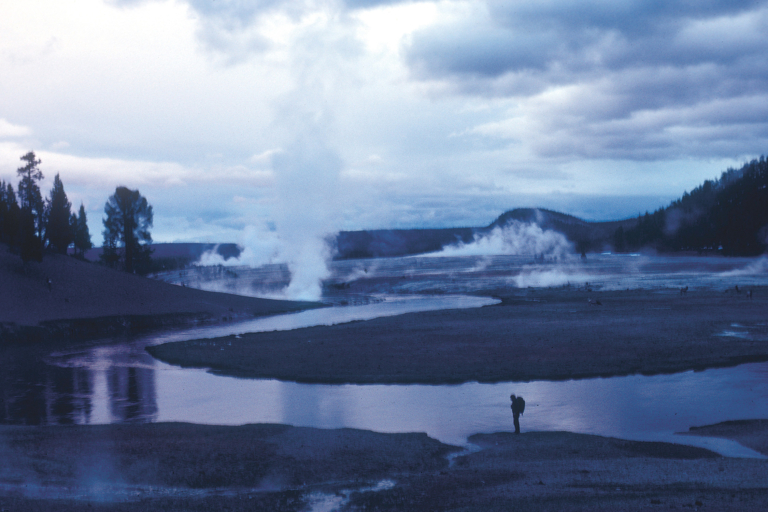
Doug walks along the Firehole River in Yellowstone’s Midway Geyser Basin in 1976. Wyoming. Photo courtesy of Doug Peacock Collection
My contact with park rangers was infrequent and cordial. Sometimes I came out of the woods to fly fish the Firehole River. My favorite bend was the Midway Geyser Basin where hot springs sprang up near the riverbank and younger grizzlies sometimes swam. In October 1968, there were very few park visitors and one ranger used to leave his patrol vehicle on the top of the golden grass-covered bluff and walk down to the river to ask how the trout fishing was. It happened to be great, with big two- to three-pound brown trout rising to small flies. His pleasant small talk constituted my entire social life.
But as soon as I hit the wilderness, I instinctually started sneaking around. I followed deep bison trails cut through the spring-snow cornices in the afternoons, where my tracks would melt away in hours, and saved snowshoe travel for cold mornings over the crusted whiteness. My camps were made deep in the timber, on the snow, or on a small patch of open ground near an isolated tree—places where no one could see them from the ground or air. I seldom kindled a fire, and then only close to thermal activity where the smoke resembled vented steam. My clothing, gear, and tents, most from Army Surplus, were all earth-colored, and I carried a white sheet in case a plane spotted me snowshoeing in the middle of a snowy meadow and I had to cover up.

Doug pays his respects to a deceased bull bison who died during a Yellowstone winter. Photo courtesy of Doug Peacock Collection
From some boyhood instinct, I considered this invisibility the correct manner in which to engage with the wild. You could conceivably cram a dozen like-minded crazies into a single valley and we’d never know anyone else was around. Treading lightly and silently, we moved slowly so we didn’t surprise and run off the wildlife. I paid close attention to all the tracks and watched the slow emergence of seasonal plants.
Early spring was my favorite time because the backcountry was empty of people. Some years, three or four feet of snow lingered under the timber and you needed snowshoes to get around: too early for hiking and too late for skis. By midday, even snowshoes wouldn’t keep me on top of the crusted snow and I would wallow forward with a full backpack at the rate of about a hundred feet an hour.
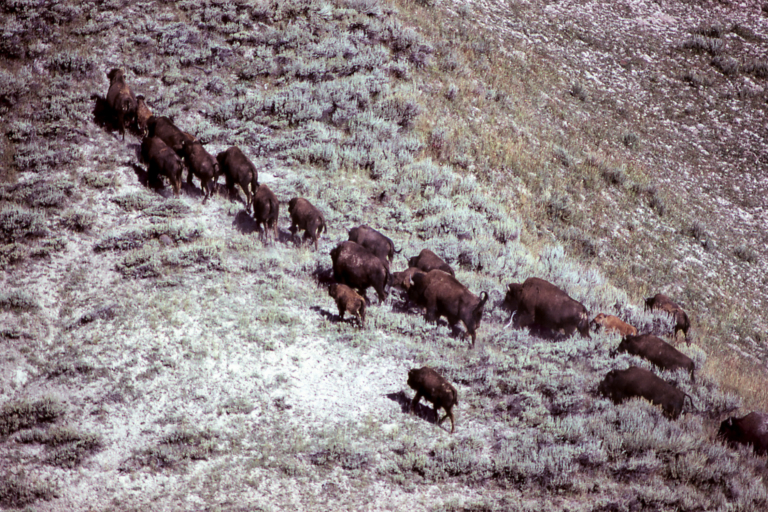
Wild bison roam the Yellowstone backcountry in 1974. Wyoming. Photo: Harlan Kredit, Yellowstone National Park Collection
Since I was interested in watching grizzly bears and I couldn’t follow them except in early morning across the deeper snows of the meadows, I would often set up on a hilltop near a thermal area. Bears exert only one-fifth of the pressure per square foot with their plantigrade gait as do humans on the snow; while bears walk on top, humans sometimes wallow. During midday, I’d watch bison or explore the small thermal spots for animal tracks and look for hot springs cool enough to soak in. By midafternoon, I’d be glassing the valleys and hills for bears; on warm spring days, grizzlies tended to be crepuscular—active in the cooler hours of dawn and dusk.
Soaking in hot springs or drainages is controversial because such activity in the park is mostly illegal today. But what a luxury those hot pools were in the snowy spring when I’d almost always choose camps in thermal zones with a soakable hot spring nearby. In the evenings, I’d carefully pad over to the thermals, alert to the occasional changing temperatures of fickle springs, and slide in, watching the celestial clock drift in the immaculate skies for twenty minutes or so. Any longer, depending on the water temperature, and you would risk passing out.
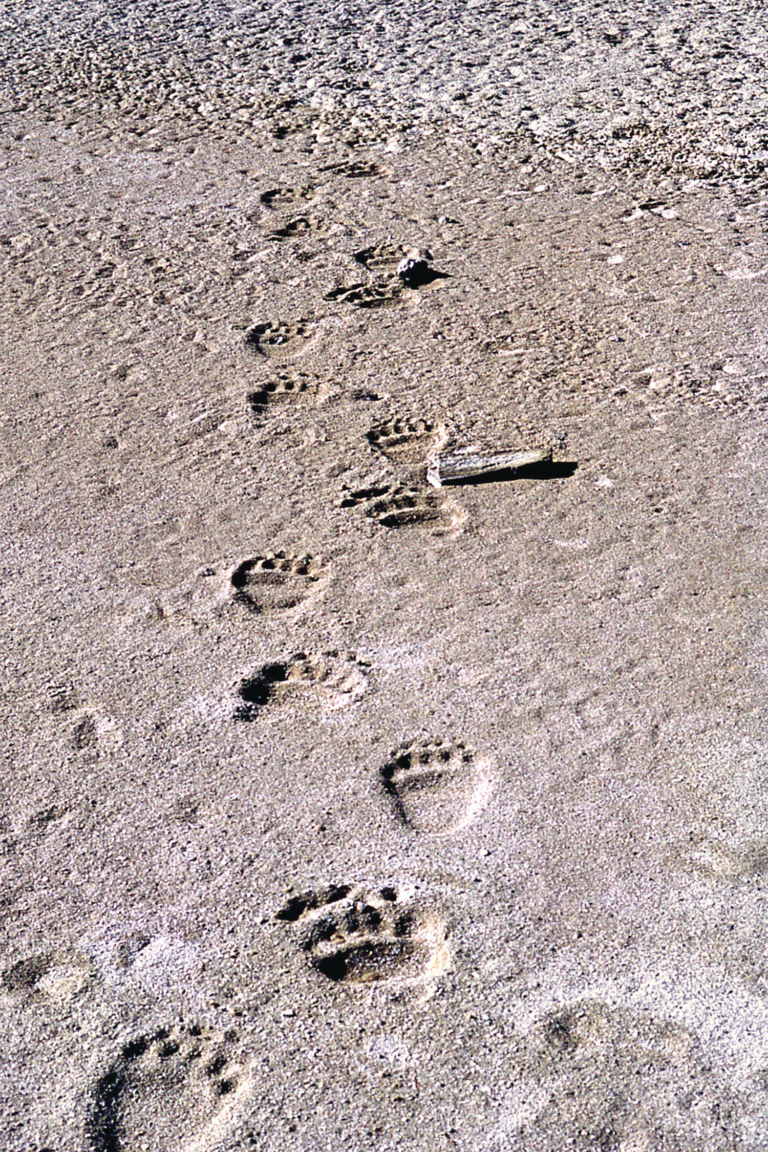
A grizzly leaves evidence of its passing on a Yellowstone National Park riverbank. Wyoming. Photo courtesy of the National Park Service
Hot springs could save your life in the winter. The closest I came to an emergency was not during winter, but in April when I broke through the ice of a small creek while wearing snowshoes. The toes of the shoes stuck in the mud and my ninety-pound backpack body-slammed me face-first into the frigid water. It took me a quarter of an hour wallowing around in the muddy creek to extract myself. By then I was thoroughly cold and shaking. Instead of taking the time to build a fire, I wandered over to a nearby, very hot spring. I knew a corner of this too-hot pool was cool enough not to boil me like a poached trout. I stripped off my wet clothes and slowly slid in. As soon as my circulation returned, I got the hell out, retreated to the timber, and built a fire around which I warmed and dried out my filthy wet gear.
